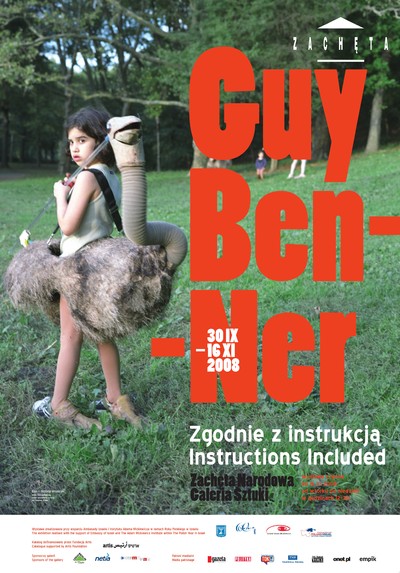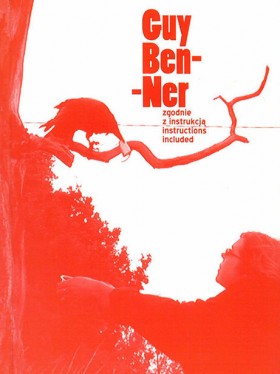Guy Ben-Ner Instrutions Included
30.09 – 16.11.2008 Guy Ben-Ner Instrutions Included
Zachęta National Gallery of Art
Several years after this event and following a number of visits to Warsaw, we open an individual exhibition by the artist under the title “ Instructions Included”. In addition to the project known from Venice, the artist presents two earlier works: Elia (2003) and Wild Boy (2004), and also the film Stealing Beauty completed in 2007, as well as his newest film Second Nature, which had its premiere at the Liverpool Biennial just shortly before its screening in Zachęta. The artist is known for his returning to the themes that interest him in successive projects in order for them to emerge in an ever-more mature form. What interests him? Is the contrast between the primordial wildness characteristic of the human race and the processes of civilization and education moulding that wildness to social norms still important?; the position of the artist in the contemporary world, his relationship to other life roles (the problem common to every creator of the need to preserve individuality against the need to fulfil oneself in the role of family father); and lastly formal and thematic cultural references: above all to literature, philosophy, film and the history of contemporary art.
In Guy Ben-Ner’s the performative element is important: in his films or video installations he appears himself, as often do members of his nearest family: his wife, Nava, and children: Elia and Amir. The individual works formally relate to different film genres: documentary film (the film Elia which appears as a nature film from afternoon television); educational film (the film instruction accompanying the spatial installation Treehouse Kit); or even other types of fictional film, with special attention to early cinema (the silent film Wild Boy, which is reminiscent of the slapstick comedies of Harold Lloyd, Buster Keaton or Charles Chaplin, in terms of its content makes direct reference to François Truffaut’s 1970 classic L’Enfant sauvage). In its turn, Stealing Beauty is a film which begins like a soap opera, but ends like a television recording of a television discussion between specialists in the fields of philosophy, politics and education. The artist’s newest work Second Nature falls between genres: a classic educational film where the heroes are animals endowed with human traits, a philosophical tractate and a family film with trained animals in a Walt Disney style. Some of the artist’s works are video-installations, others link the film media with spatial arrangements (with elements of sculptural and environment installations), while in the film Elia appear, in the artist’s own words, “living sculptures”. All Ben-Ner’s works are situated on a cusp between different genres and styles, a mix which is also reflected in their thematic content. For they blend humour with seriousness, and scenes from everyday life with quotes from favourite works of literature, philosophy, films and works of visual art. Ben-Ner’s films often look like recordings of performances, where the artist deliberately reveals the secrets of his techniques, a lack of perfection in the montage, the cheapness of shoddily made decorations; he builds complex stories through the use of a few simple props, often objects of everyday use, which for the time of the film change their function. He films the scenes in his flat or in untouched natural surroundings. He invites his own children to join him in the creation of films not addressed to children. Convention, the ironic blurring of boundaries, games serving to uncover the hidden, not always happy content, an intentional disturbance of the bases of thematic decorum: these are the features particular to the work the artist has produced to date.
The question as to the necessity of continuously adhering to conventions, of acting in accordance with the “Instructions Included” of required social roles, moral norms or one’s own expectations of oneself; a longing for freedom and simultaneously a putting into doubt as to whether escaping from conventions is possible seems to be the most important and constantly present theme in Guy Ben-Ner’s art. In his films, the artist frequently shows processes of instruction and education, often with a surprising effect.
In his works, Guy Ben-Ner often incarnates different roles: a sailor on a reconstructed ship; Robinson Crusoe — a castaway on a deserted island or a father accidentally imprisoned under his little son’s bed (a metaphor for the artist seeking creative isolation); a pioneer and builder, able to create everything from nothing (also an interesting metaphor of an artist); an ostrich guiding its flock (the species is known for the fact that the male also looks after the young); the foster father of a wild boy - Buster (named after Ben-Ner’s favourite artist Buster Keaton); a father who is not the paradigm of virtue giving his children wise counsel on the themes of life, economy and true values.
Although, obviously all the projects described deal with different issues, the autobiographical element, ever-repeated new attempts to observe his own existential situation as person and artist, appears in a less or more direct way in all the works the artist has produced to date. Guy Ben-Ner’s comic-sad works encourage contemplation and self-reflection, and evade simple diagnosis or easy solutions. They deal with the necessity and curse of having to comply with instructions.
curator Magda Kardasz
The exposition will be accompanied by a catalogue containing critical texts by authors from Israel and Poland, and reproducing works by the artist. The publication has received additional financial support from the Foundation Artis.
The exhibition was produced with support from the Israeli Embassy and the Adam Mickiewicz Institute in the frame of the Polish Year in Israel.
sponsors of the gallery: Leroy Merlin, Peri, Centrum Medyczne Damiana, Netia, A+C Systems, Klima San
sponsors of the opening ceremony: A. Blikle, Freixenet
media patronage: Gazeta Wyborcza, Polityka, TVP, TOK FM, The Warsaw Voice, onet.pl, empik
* * *
The question about the necessity of complying with norms, behaving “according to the instructions” of the dominant social roles, moral standards, or self-expectations; a longing for freedom and, at the same time, constant doubts whether it is possible to escape the social framework – this seems to be the most important and ever-present thread of Guy Ben-Ner’s work.
His films often show the processes of instruction or education, sometimes producing surprising effects. In the most direct manner in Wild Boy, where we watch an adult, a foster father, civilisea “wild child” (by negating his earlier habits and notions, and moulding him in his own image). Also the quasi-documentary Elia – Story of an Ostrich Chick, analysing the relationships in a family in which a new child has been born, contains the aforementioned threads. The narrator’s deep voice tells the story of an ostrich chick and the eternal struggle between nature and socialisation. The project I would give it to you if I could, but I have borrowed it, not shown at Zachęta, made for last year’s Skulptur Projekte Münster (an international sculpture exhibition taking place every ten years), shows a museum lesson in the history of modern art back-to-front. We see children, under their father’s supervision, rebuilding a bicycle from fragments of contemporary sculpture masterpieces by Picasso, Duchamp, Tinguely. Objets trouvés regain their original practical form. It remains an open question whether the reconstruction’s author wanted to take contemporary art to pieces for the sake of knowledge, ironically examine the eternal dichotomy between the trivial world and the world of ideas (art), or something else entirely.
Guy Ben-Ner’s moralising stories have no moral. They tell about the existential dilemmas of an individual/a man/an artist in the contemporary world, in an age of emancipation. Stealing Beauty has been shot in IKEA showrooms, in which the members of an “ordinary family” (mother, father, daughter, son) perform their daily activities and talk. The initially soap-operatic convention gradually starts to resemble a drama with elements of a socio-political discourse about possession, moral norms, and emotions, the starting point of which occurs when the parents learn that their son has stolen a small object at school. The camera is immobile, from time to time an uncomprehending IKEA customer looks into it to find out what is going on, huge price tags hang from the everyday articles amid which the filmic family resides, and the single scene of the concerned parents’ late-night conversation takes place in a sequence of almost identical beds (the scenes were shot without official permission, until being interrupted by the store personnel).
The project Treehouse Kit did not feature the artist’s family. It was designed for the space of the Israeli Pavilion at Biennale in Venice. It is a spatial installation, the main element of which is a tall tree made of wooden elements (a place where you can escape from danger or to be alone). An accompanying film shows how to use the installation’s elements to build pieces of furniture a civilised man cannot liver without – a table, a chair, a bed … Curiously, the instructions are given by a bearded man, dressed in Hawaiian shorts, who resembles a castaway/trapper, or an eremite/Old-Testament prophet. The figure’s first identifi cation tells about someone who bustles around to silence his own loneliness, while the second one defi nes someone who goes into seclusion to escape the hurly-burly of everyday life. The artist himself plays the dualistic character.
Building a house is creating a safe space, but it also a process of appropriating land (which is why the work has been interpreted as the artist’s personal commentary on the history of Jewish settlement and the Israeli-Palestinian conflict). Remaking one thing into another, destroying something to build something else, assembling found elements into new wholes, changing the function of objects (carpentry, making things, often present in Ben-Ner’s practice), can be interpreted as a ridicule of the idea of ‘do it yourself’ or as a metaphor of art, and especially the situation of the contemporary artist, who knows that “everything has already been done” and that he can only repeat familiar gestures, reinterpret, adapt, refer to his predecessors’ strategies (hence Ben-Ner’s frequent use of the technique of reenactment, e.g. in Wild Boy). He can also be drawing inspiration from the world of his personal experience.
The protagonists of Second Nature (which is in the final stages of the editing process as of this writing) are animals and humans. A raven and a fox – remember what happened to them and the cheese? The narratives built by the artist are usually humorous and perverse. This one also turns out more complicated than it looks at first sight.
Magda Kardasz
Guy Ben-Ner
Instrutions Included
30.09 – 16.11.2008
Zachęta National Gallery of Art
pl. Małachowskiego 3, 00-916 Warsaw
See on the map

